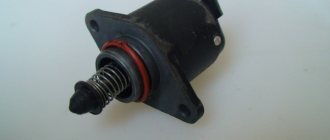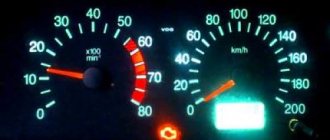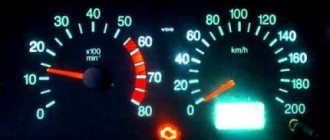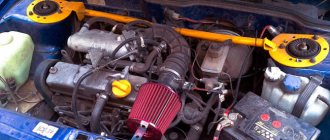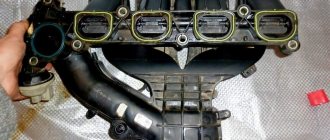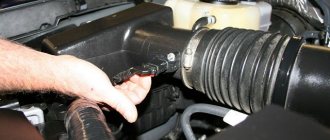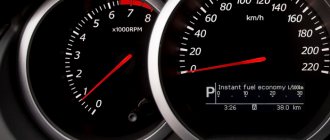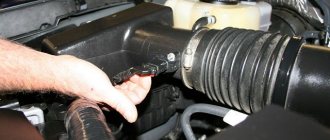After the owners try to start the engine in the morning, sometimes a problem arises: the idle speed of the Lada Granta fluctuates. This is considered one of the most significant shortcomings that arise in VAZ cars. If, after lengthy checks, it is discovered that the cause lies precisely in the throttle assembly, it is necessary to pay special attention to how air leaks through the connections of the intake receiver and the remote control.
First causes of malfunction
The electronic unit, or electronic sensor, is responsible for fuel injection and at the same time calculates the entire volume of air entering the cylinders. In addition, based on the indicators provided by other sensors, the electronic unit opens the injection solenoid valves for a certain time.
The second reason why idle speed fluctuates is constant jamming. It occurs directly in the crankcase ventilation valve. If the malfunction depends on this, the frequency with which the automatic power control sensor operates is disrupted. As a result, the sensor shows instability of engine speed. When in a faulty state, they range from 1,200 to 800 rpm.
General information
Any car owner sooner or later faces a problem when the idle speed of the car fluctuates. If the car has been in use for several years, then you will inevitably have to face this problem. In order to determine the reason for this breakdown, you need to carefully understand the design of the car.
If, when starting the engine of a Lada Granta, it is observed that as it warms up, instead of smoothly decreasing, the speed simply disappears for a few seconds, and then operates spasmodically, then the reason is 60% precisely because the idle speed fluctuates .
However, the problems disappear after the engine continues to function. All visible symptoms suddenly disappear and the engine continues to operate normally. However, the problem will repeat itself every time it is started and will not go away.
With each subsequent use of the car, this problem will only get worse. Therefore, you should not postpone its solution indefinitely, as in the future this will lead to very expensive repairs.
Elimination of floating speeds
- heads with a ratchet, and their size should be 6 and 8;
- neutral sealant, when purchasing, pay special attention to ensure that it is odorless;
- Silicone Grease;
You need to disconnect and remove the throttle cable stopper from the lever. This work must be done specifically on the throttle assembly. Next you will need to remove the resonator and air pipe. Using TORX T-25 heads and bits that were previously purchased, you need to unscrew the air filter shell. To be able to carry out this work with maximum convenience, you need to remove the wire from the exhaust receiver and all associated fasteners going to the throttle assembly.
Now, having removed the obstacle from the throttle assembly, unscrew all the bolt heads using a ratchet head to do this job. Only after this will it be possible to remove the remote control and remove the rubber rings that serve as a seal at the two ends of the throttle valve. All grooves need to be cleaned as much as possible and the FUM tape should be wound around them in a circle, about 15 times, and on the small pipe - about 10 times.
Only after completing this work can you begin to fully assemble the elements into a single whole. It would also be useful to use a clamp when securing the channel hose and the tube leading to the vacuum booster. This is necessary to further prevent air leaks in the connections.
To check whether the speed on the Lada Granta is floating, look at the IAC sensor. It is located on the throttle body, therefore, in the same place as the sensor responsible for the throttle position. It is secured with two mounting screws. In order to verify its functionality, one multimeter will be enough.
If the vehicle readings are normal, it should be within approximately 80 ohms. In the same case, if the indicators turned out to be significantly higher than the IAC norm, it will be necessary to replace it.
At the moment when the ignition is turned on directly, the rod located on the regulator fully extends and rests against a specially made calibration hole. It is located directly in the throttle pipe. After this, the sensor begins to count steps until the required time and returns the valve to its original state upon completion of operation.
So why is this happening
Root causes of problems
The most common situations in which floating speeds occur:
- Cars with a built-in electronic fuel injection system suffer from such problems much more often than others. And this happens due to the constant suction of excess air, the volume of which still increases, which leads to the formation of a malfunction. The sensor responsible for gasoline injection simultaneously calculates the volume of air entering the cylinders. Based on these and some other indicators of the sensors, the electronic unit opens the electromagnetic injection valves for some time. It follows from this that when there is an excessive amount of air in them, the sensor, which is responsible for the position of the throttle valve, shows the driver that the task assigned to the system is impossible - the check light is on. During this, the temperature sensor indicates that the engine is exiting the warm-up mode. This indicates that it needs less fuel. Just at such a moment, floating speed appears in the car at idle, because the electronic unit does not understand what to do with the accumulated excess air in the system.
- This reason also partially relates to air suction and occurs mainly on 16-valve engines. The main place where air leaks still occur is the gluing contour of the receiver elements. Even minor damage to this area will lead to unstable operation of the motor.
- Constant jamming also easily becomes a reason for the occurrence of floating speed. It occurs in the crankcase ventilation valve. Therefore, if the reason is precisely this phenomenon, the systematic operation of the automatic power regulation sensor is disrupted. As a result, the same sensor signals instability of the engine. In a faulty state, the speed ranges from 1,300 to 900 per minute.
- In models with a carburetor engine, floating speed occurs due to a violation of the control of the servomotor. To correct this problem, simply unscrew the adjustment bolts in the area of the servomotor where the sensor points to the loose drive.
- Low pressure in the fuel system causes the same problems.
- Breakdowns in the ignition system are sometimes also classified as causes of floating speed. The problem is primarily related to high-voltage wires and spark plugs. But only with a visual inspection will it be possible to understand whether they are really the problem.
- A breakdown of the IAC (idle air regulator) causes floating speeds, because it is responsible for their initial stability. The element is inexpensive and can be replaced, so there may not be any significant problems with this.
- The electronic gas pedal has a lot of disadvantages, especially if tuning the car is only in the process, but the car is actively used. Floating speed is a fairly common occurrence in such a situation.
Symptoms of floating speed
These symptoms include the widest range from 600 to 1500 rpm.
Main reasons
If similar problems occur on your car, then there may be quite a few reasons for this, but there are only six main ones.
- Idle speed control (IAC) - this part is responsible for stable idle speed. And then when it fails and unstable operation of the revolutions is observed. Since this part is relatively inexpensive, you need to pay attention to it first. It is also worth noting that during intensive use this device may exhibit soot residue from engine operation. ONLY cars in the “STANDARD” version were assembled with this unit!
Throttle assembly without idle speed control (electronic gas pedal)
Engine 21116 (high-voltage wires, oil dipstick)
Why does the Lada Granta fluctuate at idle and what to do
If the active use of the car continues for more than 3 years, the owner of the Lada Granta will not be able to avoid the problem of floating speed.
But in order to find out the true cause of what is happening on your own, you need to have at least basic knowledge about the design of your car. When starting the engine, you can observe the following picture: as it warms up, instead of a gradual decline, the speed decreases sharply, and then suddenly begins to change abruptly. In 60% of such cases, the reason is the occurrence of floating revolutions. In addition, the phenomenon often disappears immediately after the engine starts working. At the same time, visible manifestations disappear and everything returns to normal. But the situation will repeat itself in the future, and more than once.
Over time, the problem will get worse, so don’t put it off for too long. As a result, you will have to spend a lot on expensive repairs.
Pumps
If the car stalls at idle, the reason may lie in low pump pressure. On injection engines it is submersible and is located in the fuel tank itself. On carburetor engines, this element is located separately from the tank and is of the mechanical type. This pump is driven by a handle.
If the car does not start at all, it is worth checking the power to the element. Look at the fuses and relays. If on an injection engine the pump does not hum when you turn the ignition key, it means there is no power going to it. On passenger cars it is located in the rear of the passenger compartment, on the right (under the passenger sofa). If it is a diesel power unit, it is worth checking the high pressure fuel pump.
Difference between carburetor and injection filters
After a mileage of 10 thousand kilometers, it is necessary to change the air filter. It is located in a plastic or metal case (on injection and carburetor engines, respectively). If this element looks like the one in the photo below, it should be replaced.
But not only the air is purified in the system. Pay attention to fuel filters too. On diesel engines they are changed every 15 thousand kilometers. As for cars with gasoline engines, they are serviced once every 50 thousand. The throughput of these elements is 10 microns. If low-quality gasoline or diesel was used, the insides of the filter quickly become clogged. There is porous paper inside.
If there is a large amount of dirt, the element is no longer able to clean the fuel. As a result, the car does not hold idle speed and stalls. Even the fact that the pump operates under high pressure does not help. If the filter is heavily clogged, it must be changed immediately. Signs of replacement are also power losses and dips in dynamics.
Catalytic converters
With the increase in environmental standards, so-called particulate filters began to be installed on diesel cars, and catalysts on gasoline cars. They are designed for a certain service life (about 150 thousand kilometers). Over time, the core becomes clogged. The device cannot produce normal release and purification of exhaust gases.
The way out of this situation is to replace the catalyst with a flame arrester and reflash the electronic unit. But at the same time, the emission standards of your car will drop to Euro-1 values. In the countries of the European Union, the operation of such vehicles is prohibited. But if you drive mainly in the CIS, this is the most optimal solution to the problem. After all, the cost of a new catalyst and particulate filter starts from 40 thousand rubles.

